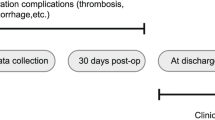Abstract
Background and Purpose:
Several unsolved problems in the treatment of cerebral aneurysms remain that could be addressed in a large multicenter registry. The Table for Optimization and Monitoring of Cerebral Aneurysm Therapy (TOMCAT) was launched to monitor the quality of care in the participating centers (http://www.aneurysma-studie.de).
Material and Methods:
Case record forms (CRFs) were developed in consensus between neuroradiologists and neurosurgeons. CRFs were collected locally and sent to the Center for Neurologic Studies (“Zentrum für Neurologische Studien” [ZNS]) in Essen, Germany. Initial clinical grade was assessed according to the World Federation of Neurological Surgeons' (WFNS) classification and outcome by the modified Rankin Scale (mRS). An mRS score ≤ 1 was defined as good outcome. After completion of a lead-in phase the database was read out for analysis. Rates of complications and of aneurysm remnants were calculated for anatomic localizations, aneurysm anatomy, and clinical presentation (WFNS).
Results:
TOMCAT was launched as prospective registry within a single center in 03/2006. With inclusion of more centers, an enrollment rate of 20 patients per month was achieved. A total of 487 patients were included. Complete treatment information was available for 315 (64.7%). In case of completed CRFs, twelve patients were untreated, 278 were treated endovascularly (EVT, among them 86 unruptured aneurysms), and 25 surgically. Stent or balloon remodeling techniques were applied in 3.6% and 3.1% of cases, respectively. Bioactive coils were used in 14.4%. In EVT, the rate of procedural aneurysm perforation was 2.3% (2/86) in unruptured and 4.3% (8/186) in ruptured aneurysms. In unruptured aneurysms the rate of permanent neurologic complications was 3.4%. The rate of residual aneurysms was 14.2%, especially in large and MCA (middle cerebral artery) aneurysms.
Conclusion:
During the lead-in phase of TOMCAT, a stable enrollment could be established. However, as not all treated patients in the single centers are sent to the central database, only preliminary conclusions can be made. First, there is a low complication rate in unruptured aneurysms. Second, MCA aneurysms still appear to represent a challenge due to high rates of complications and residual aneurysms. Third, no difference was observed in the safety profiles of bare coils and of bioactive coils. An improvement of the data collection is launched with simplified datasets and an alternative electronic submission method together with online analysis tools.
Zusammenfassung
Hintergrund und Ziel:
Es existieren noch immer verschiedene ungelöste Fragen zur Behandlung von Aneurysmen der hirnversorgenden Gefäße, die nur mit einem großen multizentrischen Register beantwortet werden können. Die „Table for Optimization and Monitoring of Cerebral Aneurysm Therapy“ (TOMCAT) wurde initiiert, um die Qualität der Versorgung in den teilnehmenden Zentren zu untersuchen (http://www.aneurysma-studie.de).
Material und Methodik:
In Zusammenarbeit zwischen Neuroradiologen und Neurochirurgen wurden Fallanalysebogen (CRFs) entwickelt. Diese CRFs wurden lokal in den Zentren gesammelt und an das Zentrum für Neurologische Studien (ZNS) in Essen geschickt. Der initiale klinische Grad wurde entsprechend der WFNS-Klassifikation (World Federation of Neurological Surgeons) und das klinische Outcome anhand der modifizierten Rankin-Skala (mRS) charakterisiert (ein mRS-Score ≤ 1 wurde als gutes Outcome definiert). Die Komplikationsraten und die Häufigkeit von Aneurysmaresten wurden für die anatomische Lokalisation, die Aneurysmaanatomie und den WFNS-Grad analysiert.
Ergebnisse:
Die prospektive Registrierung begann 03/2006 monozentrisch. Mit zunehmendem Einschluss weiterer Zentren wurde eine Einschlussrate von 20 Patienten/Monat erreicht. Insgesamt wurden bis zum Ende der „lead-in phase“ (02/2008) 487 Patienten eingeschlossen. Komplette Informationen über die Behandlung waren zum Analysezeitpunkt in 315 Fällen (64,7%) vorhanden. Nach Informationen der komplett ausgefüllten CRFs waren zwölf Patienten unbehandelt, 278 waren endovaskulär (EVT, davon 86 nicht rupturierte Aneurysmen) und 25 chirurgisch behandelt. Stent- oder Ballon-Remodeling wurde in 3,6% bzw. 3,1% der Fälle durchgeführt. Bioaktive Coils wurden bei 14,4% der Patienten verwendet. Bei EVT betrug die Rate prozeduraler Aneurysmaperforation bei nicht rupturierten Aneurysmen 2,3% (2/86) und bei rupturierten 4,3% (8/186). Bei nicht rupturierten Aneurysmen lag die Rate der permanenten neurologischen Komplikationen bei 3,4%. Die Rate residueller Aneurysmen (14,2%) war bei großen und Mediaaneurysmen besonders hoch.
Schlussfolgerung:
Während der „lead-in phase“ von TOMCAT wurde eine stabile Einschlussrate erreicht. Da aber nicht alle behandelten Patienten aus den einzelnen Zentren an die Datenbank gemeldet wurden, sind derzeit nur vorläufige Schlussfolgerungen möglich. Es wurde eine geringe Komplikationsrate bei nicht rupturierten Aneurysmen beobachtet. Mediaaneurysmen scheinen bei hohen Raten von Komplikationen und residuellen Aneurysmen nach wie vor eine Herausforderung darzustellen. Es ergaben sich keine Unterschiede im Sicherheitsprofil zwischen unbeschichteten und bioaktiven Coils. Eine Verbesserung der Datenerfassung mit alternativer Möglichkeit der elektronischen Einreichung sowie Online-Analyse- Tools ist eingeleitet.
Similar content being viewed by others
Author information
Authors and Affiliations
Corresponding author
Rights and permissions
About this article
Cite this article
Fiehler, J., Boor, S., Dörbecker, R. et al. Table for Optimization and Monitoring of Cerebral Aneurysm Therapy (TOMCAT). Clin Neuroradiol 18, 168–176 (2008). https://doi.org/10.1007/s00062-008-8021-9
Received:
Accepted:
Published:
Issue Date:
DOI: https://doi.org/10.1007/s00062-008-8021-9




